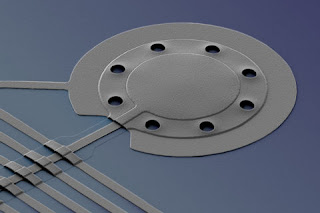NIST researchers applied a special form of microwave light to cool a microscopic aluminum drum to an energy level below the generally accepted limit, to just one fifth of a single quantum of energy. Having a diameter of 20 micrometers and a thickness of 100 nanometers, the drum beat 10 million times per second while its range of motion fell to nearly zero.
Credit: Teufel/NIST
Topics: Metamaterials, Nanotechnology, Quantum Computer, Quantum Mechanics
Physicists at the National Institute of Standards and Technology (NIST) have cooled a mechanical object to a temperature lower than previously thought possible, below the so-called “quantum limit.”
The new NIST theory and experiments, described in the Jan. 12, 2017, issue of Nature, showed that a microscopic mechanical drum—a vibrating aluminum membrane—could be cooled to less than one-fifth of a single quantum, or packet of energy, lower than ordinarily predicted by quantum physics. The new technique theoretically could be used to cool objects to absolute zero, the temperature at which matter is devoid of nearly all energy and motion, NIST scientists said.
“The colder you can get the drum, the better it is for any application,” said NIST physicist John Teufel, who led the experiment. “Sensors would become more sensitive. You can store information longer. If you were using it in a quantum computer, then you would compute without distortion, and you would actually get the answer you want.”
NIST Physicists ‘Squeeze’ Light to Cool Microscopic Drum Below Quantum Limit
Laura Ost

Comments